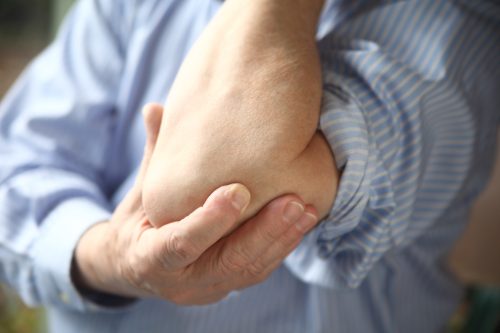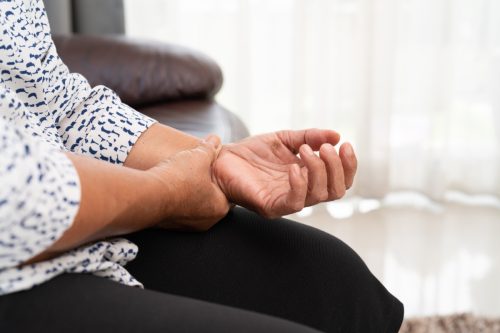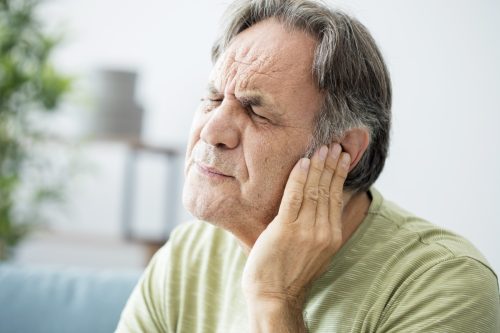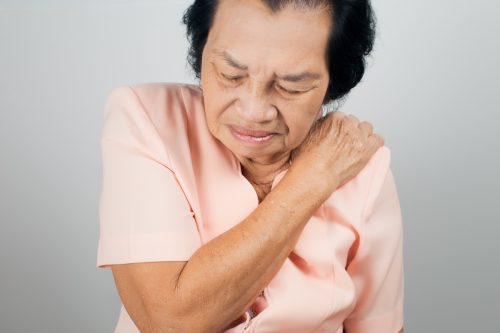25 Common Pains You Should Never Ignore

If you’re in pain, you’re not alone. According to the National Institutes of Health (NIH), approximately 11 percent of U.S. adults struggle with chronic pain. And while sometimes these aches are a natural part of the aging process, they may also be an indicator of a far more serious medical condition.
Best Life rounded up doctors, physical therapists, and other health experts to highlight some common pains you should never ignore. Read on to find out what they said—and if any of the following conditions sound like what you’re experiencing, check in with your healthcare provider.
READ THIS NEXT: Taking This Supplement Can Cut Your Pain in Half, Experts Say.
1
Lower back pain

According to an Oct. 2011 study published in The Spine Journal, lower back pain is one of the most prevalent complaints among U.S. adults. More often than not, it’s just that—a bit of pain. But in rare cases, it can be something far worse.
As Yera Patel, an orthopedic physical therapist at Kessler Rehabilitation, points out, sudden and severe lower back pain paired with bowel or bladder difficulties can be a sign of cauda equina syndrome (CES), a condition that results from something like a ruptured disc or a tumor pressing on the nerves at the base of your spine. CES requires emergency surgery—and if left untreated, it can cause permanent incontinence as well as possible lower body paralysis. If you’re experiencing serious lower back pain, it’s best to visit the ER and rule the condition out.
2
Upper back pain

When it comes to upper back pain, you also shouldn’t ignore any pangs. Serious pain could indicate an aortic dissection—a tear in the inner layer of the aorta that, though relatively uncommon, is often fatal if left untreated.
According to the Mayo Clinic, aortic dissections are known for mimicking other issues, “often leading to delays in diagnosis.” While upper back pain alone isn’t enough to instantly warrant an aortic dissection diagnosis, it’s always best to double-check. As the Mayo Clinic notes, “early detection and treatment may help save your life.”
READ THIS NEXT: I’m a Pharmacist, and This Is the Pain Reliever I Recommend.
3
Sore or weak legs

After a long run or an intense workout class, a little bit of leg soreness isn’t anything to worry about. If you’re experiencing muscle weakness and pain in your legs every time you walk, however, it could be a sign of a spinal tumor.
“As the tumor grows, it begins to put pressure on the spinal cord, surrounding nerve roots, blood vessels, and bones,” explains orthopedic surgeon Neel Anand, MD, director of spine trauma at the Cedars-Sinai Spine Center in Los Angeles. In addition to pain and numbness in the leg, other symptoms of a spinal tumor include back pain that worsens when lying down, difficulty standing, decreased sensitivity to heat and cold, and loss of control of bladder and bowel movements. Since “early diagnosis and treatment are critical,” Anand suggests seeing a doctor if your symptoms are getting progressively worse.
4
Calf aches

If you start to experience calf pain out of left field, it may be signaling the presence of a serious condition known as deep vein thrombosis (DVT).
According to internist Kristine Arthur, MD, of MemorialCare Medical Group in California, these clots “are more likely to happen after sitting or being immobile for an extended period of time like on a long plane ride or car trip.” Other silent symptoms of DVT include the skin on your leg being hot to the touch and skin discoloration.
5
Eye pain

Eye pain has become increasingly common in the digital age. In fact, the Cleveland Clinic estimates that almost 90 percent of computer users experience what is called Computer Vision Syndrome (CVS), which can result in stinging eyes, sensitivity to light, and blurred vision.
But while CVS is relatively harmless and can be overcome by altering your screen’s glare, it isn’t the only cause of eye pain. In some cases, eye pain is caused by a more intractable issue known as optic neuropathy, a condition involving inflammation around the optic nerve. According to a notable 2007 paper published in Clinical Ophthalmology, the condition damages nearby nerve fibers and “is a frequent cause of vision loss.”
Fortunately, per the Mayo Clinic, optic neuropathy can be treated with steroids, and vision typically recovers almost entirely within 12 months if attended to by a physician immediately.
READ THIS NEXT: This Is What Happens When You Take Ibuprofen 30 Days in a Row, According to Doctors.
6
Pain on the left side of your jaw

Heart issues don’t always present themselves in the form of chest pain. In fact, jaw pain may be an indicator that a heart issue is at play. According to the Cleveland Clinic, women in particular may “feel a pain that is specific to the left, lower side of the jaw.”
While this pain is most often the result of excessive teeth grinding, it’s also often reported weeks or months before a heart attack. As for the apparent strangeness of jaw pain being related to heart issues, the Clinic explains that “when there is a problem with the heart, it triggers nerves in that area, but you sometimes feel pain elsewhere.”
7
Bone pain

As you age, bone pain is the body’s natural response to wear and tear. However, the Mayo Clinic warns that it can also be a symptom of multiple myeloma, a blood cancer that affects plasma cells. In addition to bone pain in the spine or chest area, multiple myeloma typically also causes nausea, constipation, and loss of appetite.
For more health news sent directly to your inbox, sign up for our daily newsletter.
8
Lower right side stomach pangs

“Abdominal pain is challenging [to diagnose] in that we all get it at times,” says Jack Springer, MD, assistant professor of emergency medicine at Hofstra Northwell School of Medicine. Nonetheless, he explains that “pain that is severe and does not relent readily and that moves to or is mostly in the right lower belly could be acute appendicitis.”
Appendicitis affects approximately 5 percent of the population, according to the National Institute of Diabetes and Digestive and Kidney Diseases. It requires immediate surgical removal—and if left untreated, the appendix can burst and cause peritonitis, or an infection of the abdominal organs.
9
Indigestion

According to the National Institute of Diabetes and Digestive and Kidney Diseases, indigestion affects about one in four people in the United States. And while this gastrointestinal pain can occur after drinking too much coffee, it can also be one of the warning signs of cancer.
“People often overlook this symptom because they attribute their indigestion to stress or bad diet. However, chronic indigestion can be an indicator of esophageal cancer, especially if it persists for two or more months,” explains functional medicine physician Yeral Patel, MD. According to the American Cancer Society, other symptoms include hiccups, chest pain, weight loss, and difficulty swallowing.
10
Nausea

In the majority of cases, nausea is a sign of a mild illness like food poisoning or the flu. In some cases, however, this unpleasant symptom can be an early warning sign of a heart attack.
When Yale University scientists interviewed thousands of heart attack patients about their symptoms in 2018, they found that approximately 62 percent of women and 50 percent of men had experienced nausea or stomach pain at some point during their incident.
11
Stiff neck

Almost everyone experiences neck stiffness and pained movement from time to time, often due to an irregular, uncomfortable sleeping position. However, such pains may also signal a much deeper issue: meningitis, an inflammation of the membranes surrounding the spinal cord.
Meningitis often begins to show symptoms—primarily a stiff, pained neck and a sudden fever—within hours of infection. While uncomfortable, this sudden onset is actually a good thing: According to the Mayo Clinic, meningitis can become fatal “within days,” so you want to catch it as soon as possible.
12
Joint pain

In some cases, joint pain is the result of the degeneration of your cartilage due to a lifetime of movement. In other cases, it’s a sign of an autoimmune disease known as rheumatoid arthritis.
Rheumatoid arthritis attacks the lining of your joints, inflaming the surrounding tissue and even eroding the joint itself. The resulting inflammation can harm several organs including the skin, eyes, lungs, and heart, according to the Mayo Clinic.
Though no cure currently exists, there are ways to manage it. And as Thanu Jey, MD, clinic director at Yorkville Sports Medicine Clinic, told Best Life, the “condition will typically progress if untreated and limit your movement and activities in the future.”
13
Inner wrist soreness

Your wrist is largely made up of a collection of small bones, and is wrapped in very little protective tissue—so it’s no surprise that wrist pain is a common complaint. And while many of these pangs can be ascribed to natural wear and tear, if the pain occurs where your thumb meets your wrist, it may be a sign you are suffering from something called De Quervain’s tenosynovitis.
Though the cause of the condition is currently unknown, one thing is for certain: It’s quite painful. According to the Mayo Clinic, if left untreated, the pain can spread into your thumb and all the way up your forearm, making it difficult to grip objects. If you catch it early enough—within the first six months—it can be treated and eradicated with regular physical therapy sessions.
14
Cramping in your palm

In some cases, palm cramps are a sign of a serious condition called carpal tunnel syndrome, which is caused by a compressed nerve on the palm side of the wrist. In fact, it’s probably more common than you think: According to 2011 research published in American Family Physician, carpal tunnel affects approximately 3 to 6 percent of the adult population.
Fortunately, treatment—which can involve anything from splinting to surgery, depending on severity—usually results in full restoration of hand functioning, according to the Mayo Clinic.
15
Heel pressure

If you’re experiencing heel pain that isn’t the result of a new pair of shoes, it could be plantar fasciitis. According to the American Academy of Orthopaedic Surgeons (AAOS), this inflammatory condition is the most common cause of heel pain, and it often disguises itself as normal foot pain resulting from long periods of standing.
Though it can be difficult to differentiate plantar fasciitis from normal foot aches, it’s crucial to be vigilant: If left untreated, plantar fasciitis can result in chronic pain that could affect your gait. This can inadvertently injure other body parts that take on added pressure as a result, such as the knee, hip, or remainder of the foot.
16
Numb feet

Have you had your blood sugar levels checked recently? If not, it would be wise to do so. According to California-based endocrinologist Sarah Rettinger, MD, common pains and symptoms like excessive thirst, vision problems, and pain or numbness in the hands and feet can all be caused by uncontrolled diabetes.
“The progression from pre-diabetes to diabetes takes many years, so getting your HgbA1c checked every three years would find diabetes in its earliest stages,” she says.
17
Numb toes

When you sit on top of your foot in an awkward position, it’s normal for your toes to get tingly and numb. What’s not normal is to experience this sensation for no reason whatsoever. If you do, it may be a symptom of Guillain-Barré Syndrome, a rare nervous system condition categorized by numbness and/or tingling in the fingers and toes and around the mouth.
According to Michigan Medicine, other symptoms that develop as the disease progresses include muscle weakness, trouble speaking and swallowing, and back pain.
18
Hip pain

If noticeable hip pain persists, it may be a sign of bursitis, a condition affecting the fluid sacs surrounding your joints. By causing these sacs to inflame, bursitis can result in acute pain and even an inability to move your joints, according to the Mayo Clinic.
Since it’s caused by repeated stress to the joints, the likelihood of bursitis increases with age and/or physical strain. Thankfully, the condition can be reversed over time with a combination of pain injections and physical therapy.
19
Severe headache

While headaches can occur for all sorts of reasons—hangovers, dehydration, a lack of food, loud children—cranial pain may also signal the presence of a life-threatening brain aneurysm. According to the Mayo Clinic, headaches caused by brain aneurysms are “often described as the ‘worst headache’ ever experienced.” If left untreated, these aneurysms can suddenly burst, causing a stroke or even death.
And brain aneurysms aren’t the only serious condition that can cause head pain. According to neuro-oncologist Santosh Kesari, MD, chair of the Department of Translational Neurosciences and Neurotherapeutics at the John Wayne Cancer Institute, this pain can also signal a brain tumor. “Changes in frequency [and] type or intensity of headache should prompt neurological evaluation,” he says.
20
Sore throat and hoarseness

If you have a sore throat that isn’t getting better with cough drops and rest, you should set up an appointment with a specialist stat. According to Mark Dylewski, MD, chief of general thoracic surgery at Miami Cancer Institute, hoarseness is one of the symptoms of lung cancer.
Other signs to watch out for include a persistent cough, chest pain that worsens with deep breathing and laughing, loss of appetite, and fatigue.
21
Pain when you breath or laugh

Lupus is a commonly misunderstood disease. Put simply, it’s an autoimmune disease that occurs when the body destroys its own tissues and organs. It has a host of symptoms, but one of the easiest ones to overlook is pain felt while breathing.
Since lupus can cause inflammation in the lungs, the Lupus Foundation of America explains that it often results in pleurisy, or a “severe, often sharp, stabbing pain in a specific area or areas of your chest” that is made worse by taking deep breaths or laughing.
22
Pain when you pee

When most people experience pain while urinating, their immediate assumption is that they have a treatable urinary tract infection. This isn’t always the case, however.
As Murugesan Manoharan, MD, chief of urologic oncology at the Miami Cancer Institute, explains, this pain can also accompany a bladder cancer diagnosis. Other things to watch out for if you think you might have bladder cancer are blood in your urine, incontinence, a constant need to urinate, unexplained fatigue, and loss of appetite.
23
Tinnitus

Tinnitus, or a ringing in the ears, is relatively common after attending a loud event like a concert. When it’s experienced in a completely silent room, on the other hand, it’s usually a cause for concern.
According to the Mayo Clinic, it could even be a sign of acoustic neuroma, a noncancerous tumor that affects the main nerve leading from the inner ear to the brain. In rare cases, these tumors can grow to the point that they press against the brainstem and impede vital functions, so it’s best to get any ear-ringing checked out by a doctor.
24
Breast pain

“Pain is not a common symptom of early breast cancer, but a tumor can cause pain as it pushes into nearby healthy tissue,” according to nonprofit organization Breastcancer.org. “For women with inflammatory breast cancer, pain or tenderness often is one of the first symptoms.”
Unfortunately, differentiating breast cancer-related pain from menstrual-related pain is hard. “Pain or tenderness is difficult to assess,” says Richard Reitherman, MD, medical director of breast imaging at MemorialCare Breast Center. “If associated with an actual hard lump or skin thickening, you should take urgent action.”
25
Shoulder pain

In most cases, shoulder pain is caused by an intense workout or lugging around a heavy purse. In the worst-case scenario, though, it’s due to thoracic outlet syndrome (TOC), a group of disorders categorized by irritation, injury, or compression of the nerves and/or blood vessels in the lower neck and upper chest region. According to the Cleveland Clinic, TOC is commonly seen in athletes who swing their arms around and in people with sleep disorders. Other symptoms depend on the specific region impacted.
Best Life offers the most up-to-date information from top experts, new research, and health agencies, but our content is not meant to be a substitute for professional guidance. If you have specific health questions or concerns, always consult your healthcare provider directly.
- Source: https://www.nccih.nih.gov/health/chronic-pain-what-you-need-to-know
- Source: https://www.thespinejournalonline.com/article/S1529-9430(11)01162-4/fulltext
- Source: https://www.mayoclinic.org/diseases-conditions/aortic-dissection/symptoms-causes/syc-20369496
- Source: https://www.mayoclinic.org/diseases-conditions/optic-neuritis/diagnosis-treatment/drc-20354958
- Source: https://health.clevelandclinic.org/women-dont-ignore-3-subtle-heart-attack-symptoms/
- Source: https://www.mayoclinic.org/diseases-conditions/multiple-myeloma/symptoms-causes/syc-20353378
- Source: https://www.niddk.nih.gov/health-information/digestive-diseases/appendicitis/definition-facts#ref1
- Source: https://www.niddk.nih.gov/health-information/digestive-diseases/indigestion-dyspepsia/definition-facts
- Source: https://www.cancer.org/cancer/esophagus-cancer/detection-diagnosis-staging/signs-and-symptoms.html
- Source: https://www.mayoclinic.org/diseases-conditions/de-quervains-tenosynovitis/symptoms-causes/syc-20371332
- Source: https://www.mayoclinic.org/diseases-conditions/carpal-tunnel-syndrome/symptoms-causes/syc-20355603
- Source: https://orthoinfo.aaos.org/en/diseases--conditions/plantar-fasciitis-and-bone-spurs
- Source: https://www.mayoclinic.org/diseases-conditions/bursitis/diagnosis-treatment/drc-20353247
- Source: https://www.mayoclinic.org/diseases-conditions/acoustic-neuroma/symptoms-causes/syc-20356127